- Army
- Air Defense Systems
- Anti-tank systems and vehicles
- Armored Vehicles
- Armoured personnel carriers
- Artillery Vehicles and Weapons
- Command Post
- Communication Vehicles and Systems
- Electronic Warfare
- Engineer | Maintenance Vehicles
- Infantry Fighting Vehicles
- Main Battle Tanks
- Missiles
- Tactical and Logistic Vehicles
- Radars
- Unmanned Systems
- Weapons
- Navy
- Air
Tornado-G
Tornado-G 122mm MLRS
Multiple Launch Rocket System - Russia
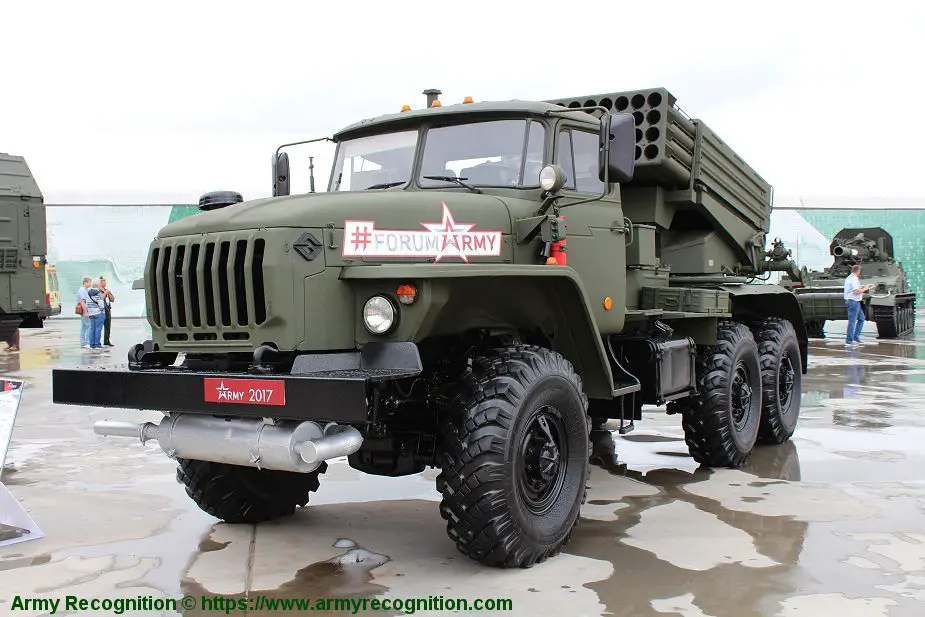
Description
The Tornado-G MLRS (Multiple Launch Rocket System ) is an improved version of the standard Russian-made 122mm BM-21 rocket launcher system based on a Kamaz or Ural-4320 truck. The Tornado-G has been designed to be fully automatic. The operating crew has been reduced to three men compared to the six-man crew of the BM-21 Grad. Previously, the BM-21 could be loaded only from the rear and there was no automatic system: everything has to be done by the cabin crew. The Tornado-G was intended to replace the old BM-21 Grad rocket launcher system. The Tornado-G is three times more efficient than its predecessors. Currently, the Tornado-G has been in service with the Russian army since 2011. The Tornado-G was demonstrated for the first time during a military exercise in 2012. On December 23, 2019, Russian Company Tecmash Group announced an upgrade for the 122mm Tornado-G multiple launch rocket systems (MLRS). On November 2022, it was announced that Russian armed forces have deployed Tornado-G for combat operations in Ukraine. Citing information published on April 25, 2023, Ukrainian armed forces have captured an undisclosed number of Russian Tornado-G which are used now against Russian troops.
Tornado-G variants:
- BM-21 "Grad": Original 40-round launcher, mounted on a Ural-375D truck.
- BM-21-1: Some systems use the Ural-43201 5-t truck chassis with a 210hp KamAZ-740 diesel engine.
2B17 or also BM-21-1: This upgrade was presented for the first time in 2003 and was developed by Motovilikha Plants from Perm. The system is fitted with a satellite navigation system NAP SNS, an automated fire control system ASUNO, APP laying system and can fire a new generation of rockets with a range of 40 km. The truck is the Ural-43201.
- 9P138 "Grad-1": lighter 36-round version, mounted on a six-by-six ZIL-131 chassis. The vehicle with supporting equipment (rockets, transporter 9T450 and resupply truck 9F380) is referred to as complex 9K55. The 9P138 can only use "short-range" rockets with a range of 15 km. He used to be known in the West as BM-21b or M1976.
- BM-21V "Grad-V" (Vozdushnodesantiy - 'airborne') (NATO designation M1975): Developed for airborne troops in 1969. A GAZ-66B four-by-four truck chassis is fitted with a 12-round 122 mm rocket launcher. The vehicle is sturdy enough to be air-dropped. Parts of the vehicle such as the canvas cab roof can be taken off or folded down to reduce its size during transit. Like the BM-21, the BM-21V has stabilizing jacks on the rear of the vehicle for support when firing. The launch vehicle has the industrial name 9P125.
- 9A51 "Prima": 50-round launcher on a Ural-4320 5t chassis. The vehicle together with fire control equipment, the ammunition transporter TZM 9T232M and the new rocket 9M53F is referred to as complex 9K59. Apparently, only a small number was produced.
- 9K132 "Grad-P": Single-round man-portable launcher, which can be reloaded and used again. The rocket itself is a 122mm fin-stabilized rocket, armed with any of the warheads used on BM-21 rockets. The weapon is not often used by the Russian military but is popular with paramilitary and guerrilla forces.
- BM-21PD "Damba" (Protivodiversionnyi): 40-round launcher mounted on Ural-375D or 43201 truck. Developed for protection of naval bases against underwater infiltrations, uses special ammunition PRS-60 (Protivodiversionnyi Reaktivnyi Snaryad). The vehicle together with the ammunition transporter is referred to as the complex DP-62 "Damba".
- A-215 "Grad-M": 22-round naval version, entered service in 1978.
Technical Data
| Armament |
|
The Tornado-G is equipped with a bank of 40 launch tubes 122 mm arranged in a rectangular shape that can be turned away from the unprotected cab. The rocket tube arrangement is a single rectangular bank of four layers each with 10 tubes. The roof of the Tornado-G crew cab is fitted with a small antenna for the GLONASS satellite navigation system. It can fire upgraded 122 mm Grad HE-Frag and HE/HEAT rocket variants, 9M538, 9M539, and 9M541. The new rocket has a much longer warhead section but without any increase in the overall length. The rockets have a maximum range of 30 km. According to Russian military sources, the new rockets of the Tornado-G could have a maximum firing range of 90 km. The 9M538 FRAG is a High-Explosive Fragmentation rocket with a length of 2.64 m, shorter than the previous 122 mm rocket 9M521 HE Frag for BM-21, which has a total length of 2.84 m. The 9M539 HE fragmentation rocket and the 9M541 submunitions rocket use a similar design. The 9M541 rocket now has 70 dual-purpose HE/high-explosive anti-tank (HEAT) sub-munitions instead of the previous 45.
|
| Design and protection |
|
The design of the Tornado-G is similar to the previous version of the BM-21, it uses the same truck chassis with the crew cab a the front and the rocket launcher system mounted at the rear. The cabin truck of Tornado-G is not protected. The launch vehicle's cabin accommodates the launch preparation and firing equipment. Individual round, selective ripple, or salvo firing is possible from either the cab or from a remote-control unit connected to the vehicle via a 60 m cable. According to Russian military sources, the crew could be reduced from 3 to 2.
|
| Mobility |
| The Tornado-G consists of a Ural-4320 truck chassis with a rocket launcher system mounted at the rear of the chassis. The truck Ural-4320 is motorized with a water-cooled V-8 240 hp. gasoline engine YaMZ-238M2 engine. The Tornado-G can run at a maximum road speed of 82 km/h with a maximum road range of 800 kilometers. The truck can cross fords up to 1.5 m deep. |
| Accessories |
| The truck of the Tornado-G has a collapsible canvas cab, removable doors and windscreen, telescopic steering wheel, and tie-down points for aiding parachute dropping and landing. A panoramic telescope can be used for sighting. The Tornado-G is based on the BM-21 Grad but equipped with a satellite guidance system. The weapons system is equipped with an automated laying and fire control system, along with autonomous satellite navigation and positioning system. |
 The Tornado-G is equipped with a new satellite guidance system. |
| Combat use |
| According to the Russian manufacturer, the new MLRS Multiple Launch Rocket System Tornado-G is designed to strike armored vehicles, artillery mortar batteries, and command posts. The striking is increased to 40 kilometers. The Tornado-G used new ammunition and can strike multiple targets. The system is able to strike not only a single target but also a group of targets like columns, enemy concentration, and deployment area. |
Specifications
| Armament | Armor |
| 40 launch tubes 122 mm caliber | No armor |
| Country users | Weight |
| Russia, Ukraine | 14,000 kg |
| Designer Country | Speed truck |
| Russia | 85 km/h |
| Accessories | Range truck |
| Satellite guidance system, panoramic telescope | 650 km |
| Crew | Dimensions |
| 3 or 2 | Length: 7.35 m; Width: 2.40 m; Height: 3.09 m |
Details View
| a | |
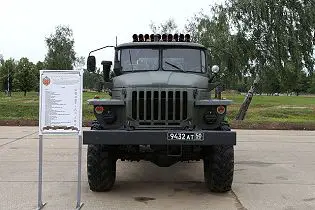 |
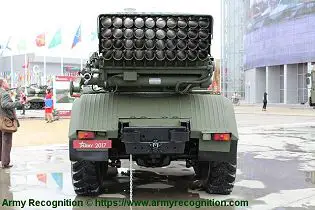 |
| a | |
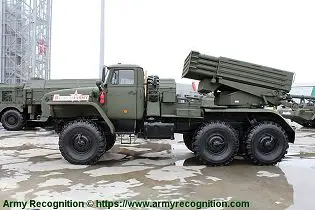 |
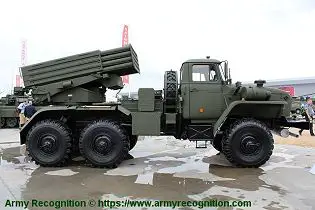 |
Pictures - Video



























